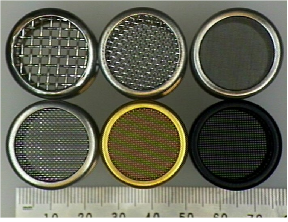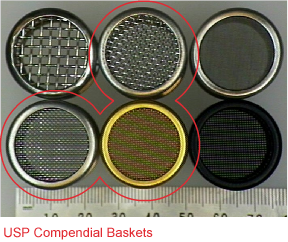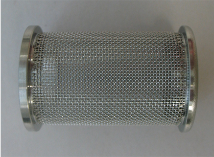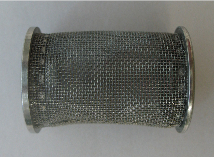Testing Novel Dosage Forms and Non-Compendial Modifications
to Dissolution Apparatus: Apparatus 1 Baskets
- Overview:
Baskets Baskets Modifications
The ICH Harmonized Basket is used in all dissolution tests unless otherwise specified. This basket is based on a historical 40-mesh basket with a square aperture of 0.40 mm and 0.25 mm wire thickness. 20-mesh baskets have been approved for certain products but are only to be used as required by the method or monograph.
USP baskets are typically made from stainless steel, type 316 or equivalent. To reduce the corrosive effects of the media on the steel, these baskets may also be coated with a 2.5 µm thick layer of gold.
The photo below shows a range of baskets available.
Click the different meshes for more information.
Click the button across to highlight USP Compendial baskets.
10-Mesh Stainless Steel Basket
The 10-mesh basket is constructed of stainless steel similar to the 40-mesh basket; however the 10-mesh basket is a non-Compendial (unofficial) basket.



Baskets are fragile in comparison to paddles and become unusable within 3-5 weeks when exposed to 1 Normal HCl. For this reason, baskets can be gold plated, which prolongs their life for up to several months.
316 stainless steel is resistant to rust and corrosion, but will still corrode over a long period of time - the wire will become thinner, resulting in larger openings and particles will fall out sooner and settle in the bottom of the vessel where they may not pass into solution as quickly. Visual inspections should be performed on a regular basis.
New Baskets
New stainless steel baskets are shiny
and appear in good operating condition.



